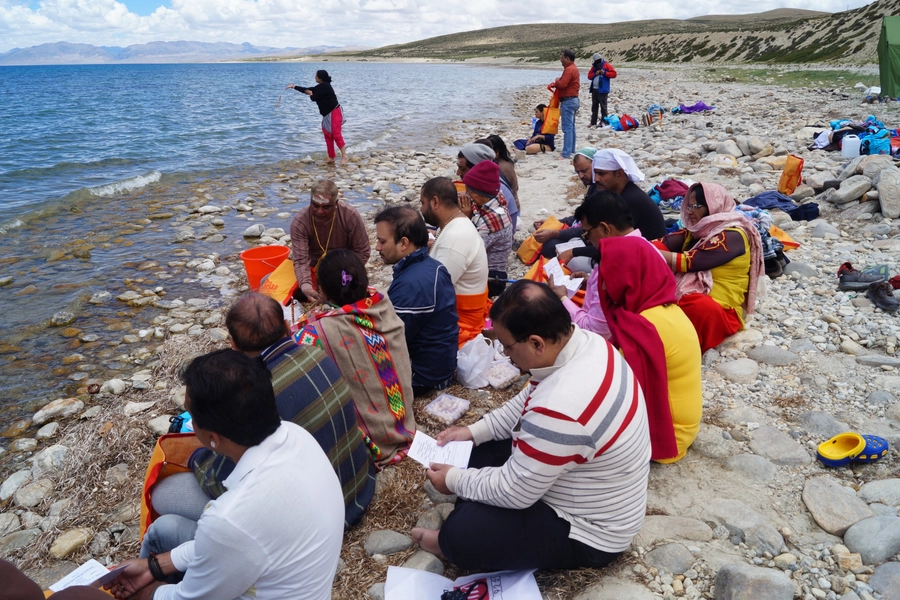Lake Mansarovar: Know Everything about Tibet’s Sacred Lake
Lake Mansarovar, the most sacred lake in the world, is situated close to Mount Kailash, with an elevation of 4,590 meters, and is surrounded by several Buddhist monasteries, Chiu Gompa, and Seralung. It has crystal-clear water that symbolizes light and positivity. The word ‘manasarovar’ is made up of two words, ‘Manas’ (mind) and Sarovar (lake); Hindus believe that Lake Mansarovar was formed on Earth as a manifestation of Lord Brahma. Globally held as the world’s highest freshwater lake, it carries herbal properties, while performing its parikrama, liberates one from the human lifecycle. Similarly, Buddhists believe that Queen Maya, Lord Buddha’s mother, who conceived at Lake Mansarovar, and Jains consider it a place of enlightenment, as Rishabhanatha, the first Tirthankara, attained enlightenment. Visit from May to September, or typically during April, May & June, as the weather remains pleasant and there’s no snowfall. You can perform puja at Lake Mansarovar and bring home its holy water.
Did you know that Tibet’s Lake Mansarovar is believed to be one of the world’s highest freshwater lakes? The universe is blessed with several beautiful lakes; however, not every lake's water is spiritual and healing. As per Hindu texts, the water of fives lakes, often called ‘Panch Sarovaras’: Kailash’s Mansarovar (Tibet), Bindu Sarovar (Odisha), Narayan Sarovar (Gujarat), Pampa Sarovar (Karnataka), and Pushkar Sarovar (Rajasthan), is believed to be holy.
Did you know, Swami Pranavananda, the greatest spiritual leader of modern India, circumambulated nine times the Mansarovar Lake in Tibet?
Well, Lake Mansarovar is one of Tibet’s most popular tourist attractions and has been drawing millions of pilgrims from across the world. It has several spiritual and scientific significances, folktales, mysteries, and so on. Continue reading further to know more about the Lake Mansarovar pilgrimage.
About Lake Mansarovar
Mansarovar Lake or Mansarovar Jheel is one of Tibet’s natural wonders, located at an elevation of 4590 m, at the southern base of Mount Kailash in the Tibet Autonomous Region (TAR), with a depth of approximately 330 feet. This lake is regarded to be sanctified in Buddhism, Jainism, and Bon religions and considered to have the holiest water. Interestingly, one can spot fish swimming in the Lake’s water, and beautiful swans or migratory birds can be spotted near its shoreline.
Generally, Mansarovar is derived from two words: ‘Manas’, which means mind, and ‘Sarovar’, meaning lake. In the Tibetan language, Lake Mansarovar, Tibet, is also called Mapham Yumtso, which translates to ‘invincible lake’. Mansarovar Kailash Yatra holds great spiritual significance not just for Hindus but for Buddhists, Jains, and Bons as well.
Earlier, this sacred lake of Tibet was surrounded by several Buddhist monasteries such as Chiu, Bonri, Seralung, Yerngo, Trugo, Langpona, and Gosul, which represent the Buddhist wheel of life, with eight gompa located in proximity
History and Spiritual Significance of Lake Mansarovar
While Mount Kailash is the centre of the universe, Lake Mansarovar is believed to be the heart of the universe. It symbolises purity, positivity, hope, renewal, and light as compared to Rakshastal Lake (Ravana Tal), another lake located close by, which is believed to be demonic in nature, representing darkness and negativity.
Hinduism: According to Hindu beliefs of Mansarovar, the Mansarovar Jheel was first visualised and descended on the Earth from heaven by lord Brahma. Hindus typically visit Lake Mansarovar after Kailash Parvat darshan to perform parikrama of Lake Mansarovar. Sapta Rishis are believed to have performed penance there and worshipped a Shiva Lingam, which originated from the lake itself. Also, pilgrims perform Hawan & pujan at the Hindu sacred Lake Mansarovar as an important ritual of their Tirth Yatra.
Buddhism: It is mentioned that Queen Maya (the mother of Lord Buddha) conceived close to this lake, which makes Mansarovar a revered pilgrimage site for Buddhists. During Kailash Parikrama, it is believed that circumambulating the lake and crossing through the eight gompa located closely implies a single symbolic turn of the wheel. Buddhists also believe that the lake is identical to Anotata Lake. As per popular legend, the lake’s appearance is described with Buddha and Bodhisattvas, floating in the Lake while sitting on lotus flowers.
Jainism: For Jains, Lake Mansarovar is the symbol of enlightenment and spiritual awakening, as Rishabhnatha, the first Tirthankara of Jains, attained enlightenment at Mount Ashtapada (Kailash in Jainism) in the Mansarovar region, making it a revered Jain pilgrimage site.
Lake Mansarovar: Key Rituals Performed During Kailash Mansarovar Yatra
One of the most important and significant rituals performed during Kailash Mansarovar Yatra is the Lake Mansarovar parikrama which is believed to usher in renewal and positivity in the lives of pilgrims. The water of the lake is used as a remedy to cure any kind of illness. Moreover, Hindus usually perform pujan near the Lake, and for the same, Trip To Temples organises hawan and pujan near the lake. You can check out our Kailash Mansarovar Yatra packages to learn more about the parikrama of Lake Mansarovar.
Parikrama of Lake Mansarovar
The Parikrama of Lake Manasarovar earlier used to be 105 km, but now it has been reduced to roughly 90 km due to global warming. It takes about 3 hours to complete Manasarovar Lake Parikrama by Volvo category buses. One can see Kailash Parvat throughout the Parikrama route of Mansarovar Jheel. The parikrama of Lake Mansarovar is believed to purify the soul and liberate one from the human lifecycle while also helping one in self-realisation.
Is Lake Mansarovar mysterious?
Do you know the mystery of Lake Mansarovar? Lake Mansarovar’s crystal-clear waters have enchanted every traveller, adding natural splendour to the region of Mansarovar. There are several lakes located in the Himalayas: Lake Rara, Phewa Lake, Gosainkunda Lake, Shey Pokshundo Lake, Tilicho Lake, Gokyo Lake, Namtso Lake, and Mansarovar Lake. Among these holy Himalayan lakes, Lake Mansarovar has mysteries associated with its existence and origin.
Well, the atmosphere surrounding Lake Mansarovar is believed to naturally possess therapeutic properties, with its water being rich with curative herbs. It’s radioactive springs contain healing properties. Additionally, gold fragments were found near the south-west corner of Mansarovar, south of Chiu Gompa. The godly swans and aquatic birds also swim on the surface of Lake Mansarovar.
Note: As per recent announcements by Chinese authorities taking a dip in the Lake Mansarovar or bringing in Jal (to home) is strictly prohibited.
When can I plan the Lake Mansarovar Yatra?
The best time to do the Lake Mansarovar Yatra is from May to September. Pilgrims typically visit Lake Mansarovar during April, May, and June, as the weather is pleasant and there is no snowfall. The temperature usually remains moderate during the summer season, which makes it the ideal time to plan for Lake Mansarovar Yatra.
Got questions? We’re just a click away! Reach out to our team of experts at +918510007751 to know more exciting information on Lake Mansarovar.
Get in Touch
Have An Enquiry? Write To Us…
Related Packages
Related Blogs
Information Links and Downloads
Talk to Kailash Yatra Expert
Submit your contact number.
Kailash Yatra Expert will call You within 1 minute.
(24X7 Free Service, India Number only)
Get All Details on Mobile


Question and Answer
Related Packages

Kailash Mansarovar Yatra from Lucknow by Helicopter
10 Night / 11 Days
- Panditji at Mansarovar Lake
- Portable toilets at Mansarovar Lake
- Complimentary stay at Lucknow
Stay Plan
- Lucknow (1N)
- Nepalgunj (1N)
- Purang (2N)
- Lake Mansarovar (1N)
- Darchen (1N)
- Deraphuk (1N)
- Zuthulpuk (1N)
- Purang (1N)
- Lucknow (1N)

Kailash Mansarovar Aerial Darshan
2 Night / 3 Days
- Special hawan pujan
- Lucknow-Nepalgunj by car
- 4 star hotel stay
Stay Plan
- Lucknow
- Nepalgunj(2N)
- Lucknow
EMI from ₹1544
Related Blogs

We Got Featured in the Media
Stay Connected for All Updates!
For the latest updates on Kailash Mansarovar Yatra, Adi Kailash Yatra
and other incredible travel destinations, make sure you’re following our channel

 WhatsApp
WhatsApp Instagram
Instagram
 Send
Send Comment
Comment

















